Looking for the best landmarks in South America? Worry not.
The 17.84-million-kilometer-squared continent is dotted with a huge variety of landscapes. From the glistening Caribbean coast to the soaring Andean Mountains to the lush Amazon Rainforest, these varying landscapes are the perfect breeding grounds for stunning landmarks.
Below we will talk about 25 of the most iconic South American landmarks. Each landmark is sorted by the country it is located so you can have an easier time locating them!
Enjoy!
Best Landmarks in Argentina
1. Iguazu Falls
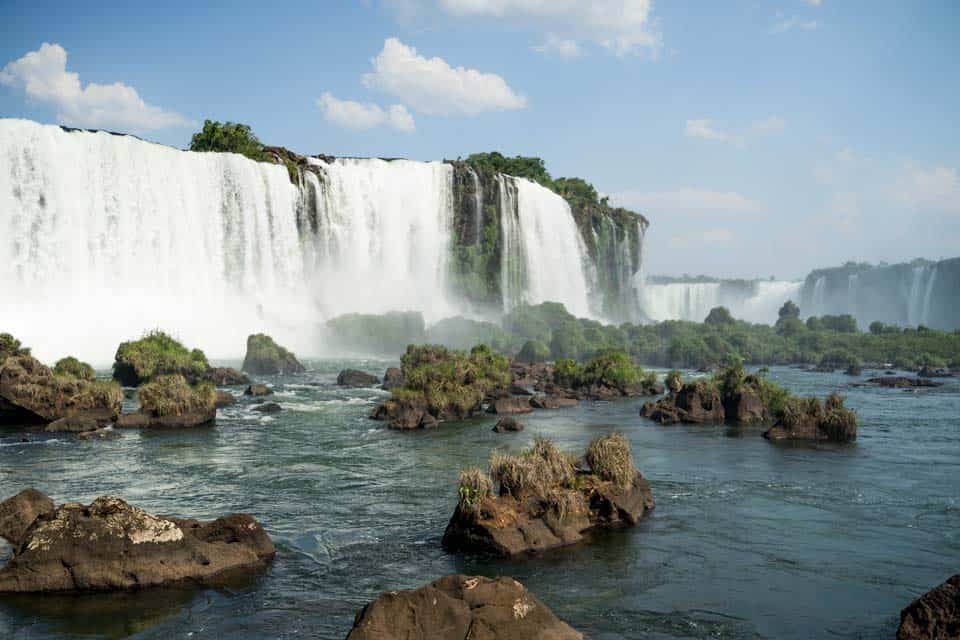
The Iguazu Falls are one of the most extraordinary natural landmarks in South America. Comprised of a total of 275 individual cascades, Iguazu Falls is the world’s largest broken waterfall.
Named as a UNESCO World Heritage Site since 1984, Iguazu Falls is one of the most spectacular sights in South America. 275 falls rushes over the Parana Plateau over a gulf of nearly 2 miles in length.
But the powerful forces of water aren’t the only thing nature has to show us in this incredible South American tourist attraction. Iguazu Falls are surrounded by a lush sub-tropical rainforest, which is home to many specifics of plants, birds and mammals.
Geographically, Iguazu is located on the border of Argentina and Brazil. If you want a more up-close encounter with this magnificent natural creation, the Argentina side is better. If you want panoramic views of the Falls, head to the Brazilian side. Better yet, check it out from both sides!
2. Perito Morena Glacier
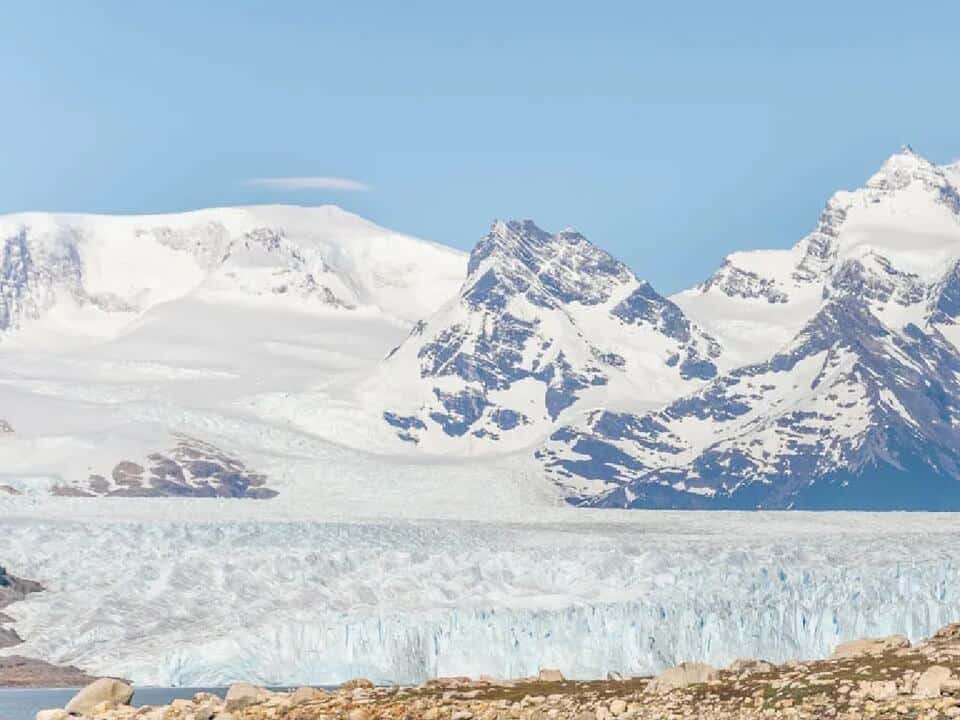
By: Bailey of Destinationless Travel
Perito Moreno Glacier is one of the most famous places to visit in all of South America. This glacier is huge – and seriously impressive in the sense that it is actually growing (as opposed to shrinking like most glaciers around the world.)
The glacier is super active, meaning that when you visit you will likely get to watch huge chunks of ice break off the edge of the glacier and crash into the water below. Some of these ice chunks are sometimes as large as houses and it is mesmerizing to watch
Perito Moreno Glacier is located in Los Glaciares National Park about 80 km from the small town of El Calafate in Argentina. Most people visit Perito Moreno Glacier on a day trip from El Calafate. You can either rent a car and drive yourself there, or, join one of the many Perito Moreno Glacier tours.
If you visit on your own you will be limited to just seeing the glacier from the expansive boardwalks. The views from here are amazing, but not nearly as good as on an ice-trekking guided tour where you actually walk on the glacier using ice cleats.
The national park where the glacier is located is only open during daylight hours which change depending on the season.
It costs 800 Argentinian pesos to enter the national park (at the time of writing) and this fee is paid at the entrance gates about a 30-minute drive from the glacier. At the glacier, you will see kilometers of boardwalk and viewing platforms, a restaurant and café, as well as a place to rent kayaks.
3. Teatro Colon
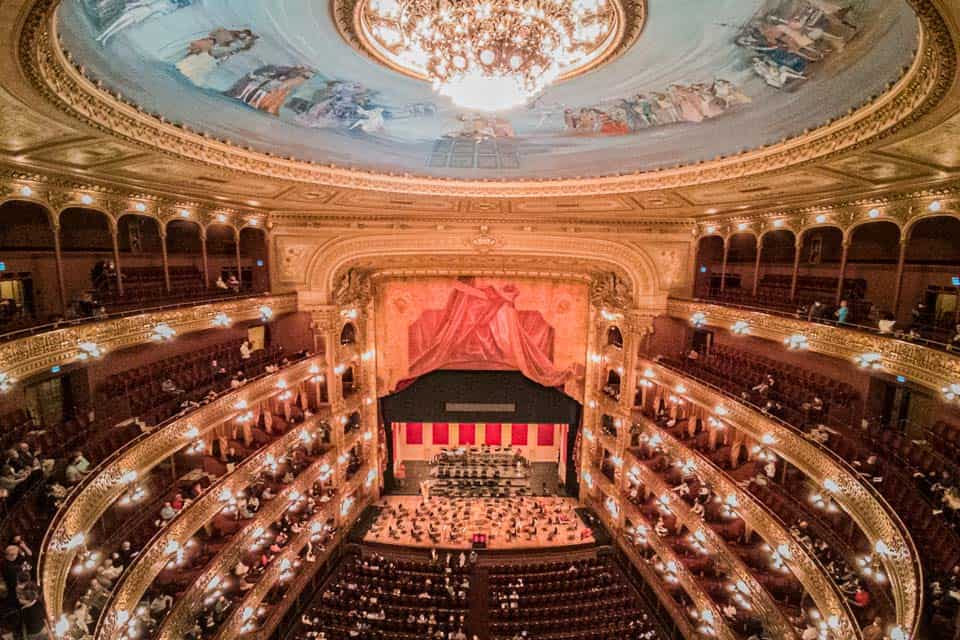
By: Roxanne of Faraway Worlds
Widely considered one of the most beautiful theaters in the world, Teatro Colón was built in Buenos Aires in the early 20th Century and is a National Historic Monument in Argentina. Caruso, Callas and Pavarotti have all performed at the theatre and it is still one of the world’s top opera houses for its acoustics.
While the exterior of the building is impressive enough, the interior is magnificent with sweeping staircases, velvet seats and tapestries on the walls. If you’re in Buenos Aires, visiting the theatre is a must.
There is usually a full program of opera, ballet and orchestral performances at the theatre, which is the best way to experience the remarkable acoustics for yourself.
If you can’t make one of the performances, it’s well worth going on a backstage tour which takes you through the opulent building and gives you an insight into its history and heritage. Tours take about an hour and tickets are affordable enough to fit most travel budgets.
4. The Southern Fuegian Railway (End of the World Train)
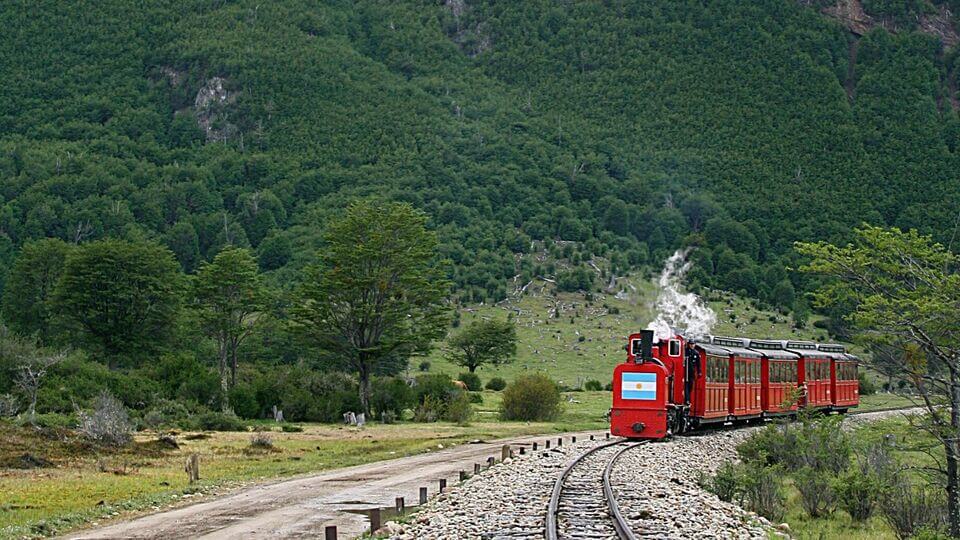
By: Pamela of The Directionally Challenged Traveler
One of the most iconic landmarks in South America, the Southern Fuegian Railway, is located at the southernmost tip of the continent. In the deep south, the prison town of Ushuaia, Argentina is nestled comfortably at the foot of the mountains.
As a base for the majority of cruises heading to Antarctica, Ushuaia has the nickname “el fin del mundo” meaning “the end of the world.”
The town was meant to home prisoners, but first, they had to build their own prison. They did this by using wood from Tierra del Fuego National Park. In order to make it easier, they built the Southern Fuegian Railway – or the train at the end of the world.
The train rain from the late 1880’s until 1947 when the prison closed down. In 1949, the railroad was blocked by an earthquake. In 1994, the railway was rebuilt for sightseeing and even includes a luxury option that includes champagne and dinner services.
The train runs over Pipo River, through the Tierra del Fuego, past the Cemetery of Trees (where you can really see all the work the prisoners did in the forest), and see some incredible waterfalls and landscapes!
Riding the train at the end of the world is not something to miss when visiting South America!
5. La Recoleta Cemetery
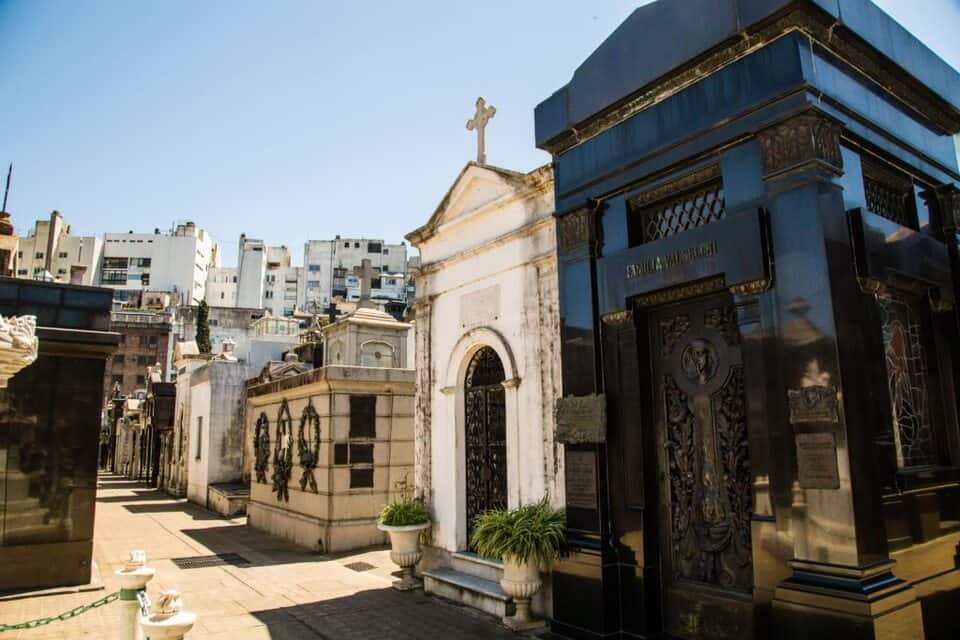
By: Lindsey Puls of Have Clothes, Will Travel
Visiting a cemetery may sound morbid and depressing, but Argentina’s La Recoleta Cemetery is here to prove that wrong.
As an above-ground cemetery filled with beautiful mausoleums, carved scrollwork and stately pillars. La Recoleta Cemetery is filled with works of art!
This cemetery, located in the Recoleta neighborhood of Buenos Aires, was declared the city’s first official public burial place in 1822. La Recoleta is the resting place of many of Argentina’s famous historical figures, such as Eva Perón.
There are 6,400 graves here, each beautiful and unique in a variety of architectural designs. You can spend hours wandering through La Recoleta.
One of the most beautiful tombs in the cemetery is that of Rufina Cambaceres. It is a stunning Art Nouveau tomb that depicts a young woman tearfully opening heaven’s door.
Rufina was mistakenly pronounced dead and was buried alive. She died trying to open her coffin. After this, her mother rebuilt her tomb into the masterpiece you see today.
Best Landmarks in Bolivia
1. Salar de Uyuni
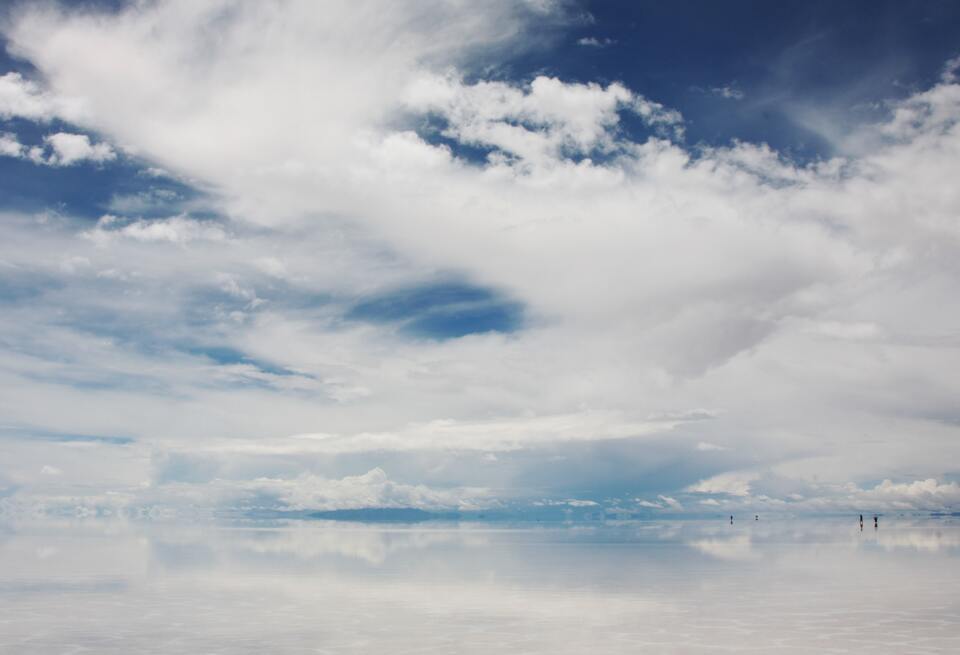
By: Mal of Raw Mal Roams
Salar de Uyuni, situated in southwestern Bolivia, is the largest salt flat in the world, stretching approximately 11,000 square km and a few meters in depth. One of the most interesting Salar de Uyuni facts is that it was formed as a result of the evaporation of a massive salt lake – Lake Minchin.
There are no roads on the salt flats, but there are a few islands that were volcanoes in the past. One of the most popular islands in the salt flats is Incahuasi Island, covered in sharp rocks and prehistoric giant cactuses.
The best way to see the beauty of the Salar de Uyuni is to go on a tour that lasts at least two days, and it will allow you to see the most exciting parts of the Salar, such as various lagoons inhabited by flamingos.
Between November and March, Salar de Uyuni experiences a wet season, and it’s when you can experience the famous mirror effect.
2. Great Train Graveyard

By: Raksha of Solo Passport
Also known as the Cementerio de Trenes or Great Train Graveyard, the train cemetery in Uyuni is one of the interesting places to visit in South America. The train cemetery has more than 100 rusted train cars to explore and most of these trains have been exported from Britain, some dating back to the 20th century.
The train cemetery is very popular among tourists and is usually very crowded during the day. The best time to visit is in the early morning, during the sunset or after dark to view the stars. Sunsets are dramatic as the sky lights up and are perfect for beautiful backdrops.
Just about 3 kilometers from the center of Uyuni, travelers can arrive on foot or by a short taxi ride. There is no entrance fee to visit the train cemetery and as it is closer to the city, it can be visited as many times as one wants. Even though Uyuni is relatively safe, it can get isolated, especially at night.
Best Landmarks in Brazil
1. Christ The Redeemer
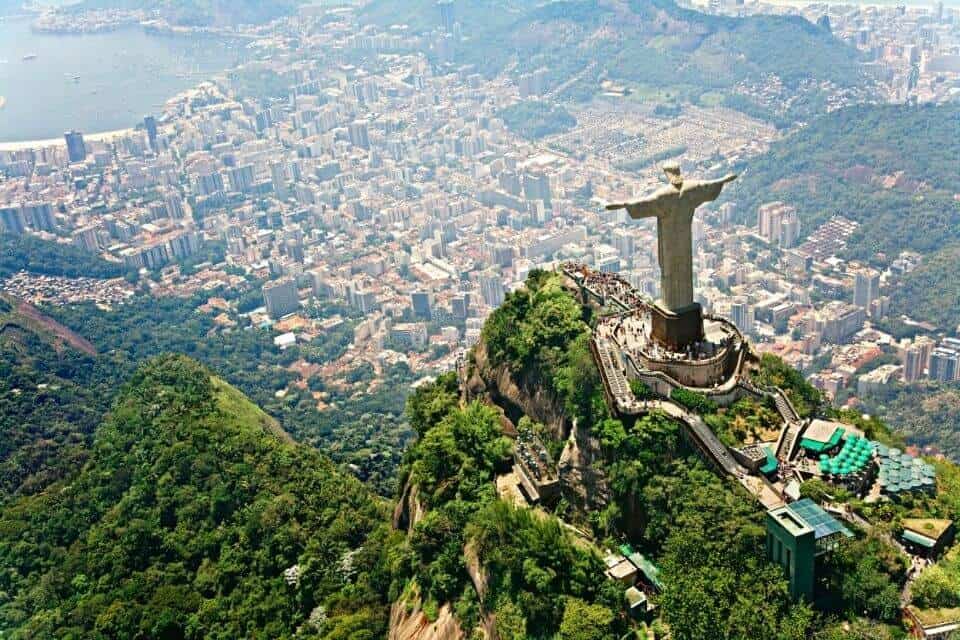
By: Heather of Conversant Traveller
Standing proud as one of the Seven Wonders of The World, the Christ Redeemer statue in Brazil receives millions of visitors each year. Perched high up on the hillside overlooking Rio de Janeiro, this enormous Art Deco installation is a remarkable feat of engineering and design.
Constructed in the 1920s as a symbol of Christianity, Christ Redeemer is intricately crafted from thousands of minuscule soapstone tiles. Many of them have secret messages on the back from the workers who helped bring the statue to life.
Visitors can ascend the mountain by cog train from Cosme Velho, enjoying views of the Tijuca National Park along the way. Alternatively, you can catch a shuttle van up, or even hike if you’re up for a challenge (go in the morning when temperatures are cooler).
At the top, there’s a long balcony at the foot of the statue, with superb panoramic views over the city and bay. Head right to the end for the best photos of the statue itself, although you may have to wait a while as it’s the most popular spot!
If you are in Rio de Janeiro at night, you can even see the statue lit up from far away!
2. Sao Paulo Museum of Art (MASP)
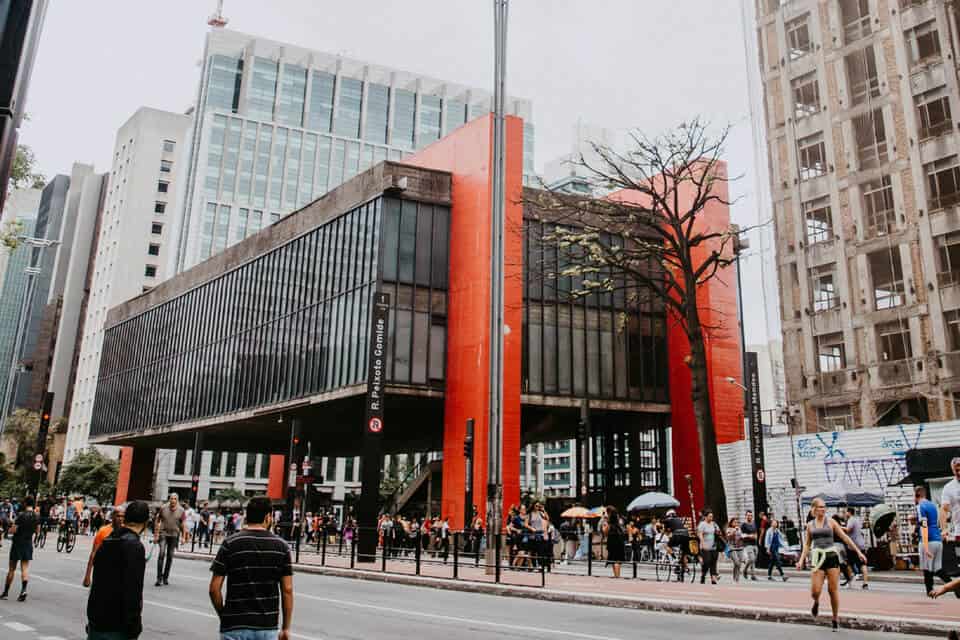
By: Bruna of I Heart Brazil
The Sao Paulo Museum of Art, also known as MASP, is one of the most important museums in Brazil
Currently, it holds roughly 11,000 works of art from many international artists, including Van Gogh, Monet, and Picasso
However, the cherry on top is the modern and quirky building itself
Resembling a suspended container, the museum is a rectangular concrete and glass structure held 26 feet above the ground by four red concrete beams
The museum reaches a total height of 58 feet, and the free span underneath it is used for many purposes, from fairs to protests
Listed as a national heritage construction, the MASP is open Tuesday-Sunday, including most local holidays.
While the entrance ticket is very affordable, you can enter for free every Tuesday as well as every first Wednesday of the month. One more reason not to miss this incredible landmark in Brazil!
Best Landmarks in Chile
1. Torres Del Paine National Park
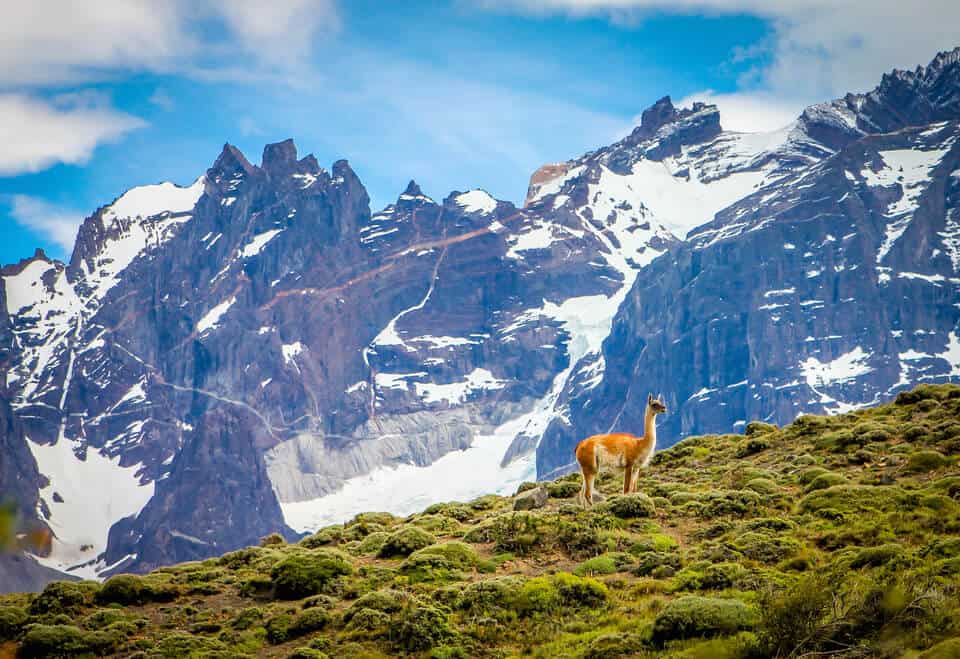
By: Bret Love & Mary Gabbett of Blue Ridge Mountains Travel Guide
The remote wilderness experience you’ll find in the Patagonia region of South America is like heaven on earth for nature lovers.
While Argentina is home to many of the best attractions in Patagonia, Torres del Paine National Park is the most popular place for hiking in Chile, offering majestic mountain summits and hundreds of kilometers of trails.
The national park’s scenery is truly jaw-dropping, with glaciers, lakes, moraines, and valleys filled with wildflowers and wandering herds of guanacos. There are towering granite peaks that loom large over the rugged landscape (including the iconic Paine Massif) and vast fields of wind-blown grasses that ripple like waves on a sea of green.
The area’s expansive array of wildlife, including pumas, foxes, caracaras, and the massive Andean condor, is equally impressive.
The best hiking experience available in Torres del Paine is the world-renowned W trek, which is named after the shape of the trail. The 4-day hike allows visitors to see some of the park’s most iconic sights up close, including the namesake Torres (three granite towers overlooking a brilliant blue lake), Glacier Grey, and the Valle Frances.
Hardy trekkers who have extra time on their hands may want to consider hiking the Circuit, a seven to nine-day trail that includes the W and the rarely visited northern side of the park.
If you want magical Patagonian landscapes with virtually no one else in sight, this is a great way to see why National Geographic called the region, “Eden at the End of the World.”
2. Gran Torre Santiago
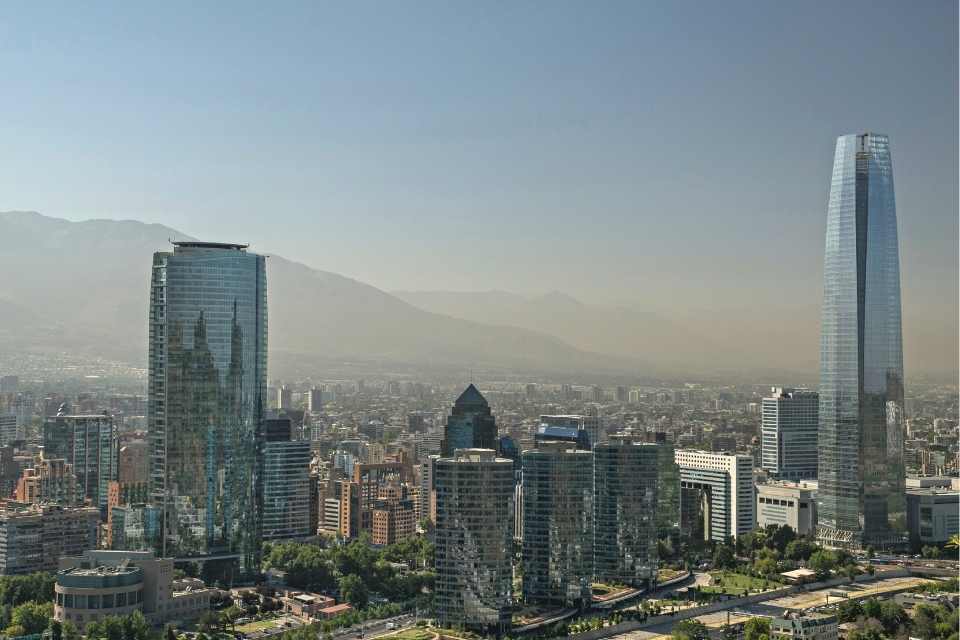
By: Cecilie of Worldwide Walkers
Gran Torre Santiago is one of the most famous buildings in South America. It’s an incredible skyscraper designed by famous Argentine architect César Pelli, and it’s located in bustling Santiago de Chile.
With its 300 meters height, Gran Torre Santiago is considered the tallest building in all of South America, and the second tallest in all of Latin America.
You can easily visit Gran Torre Santiago on your trip to South America. Located on the ground floor within the Costanera Center Complex, you’ll find the entrance to Gran Torre Santiago. Here you can take the elevator to the Sky Costanera observation deck on the 61st floor.
The observation deck offers incredible 360 views over the city of Santiago – including the San Cristobal Hill and the Andes Mountain Range. From the 61st floor, you can also take the escalator to the 62nd floor, which is designed as an open-air space.
Visiting Gran Torre Santiago is a unique experience that all skyscraper enthusiasts would cherish, and it’s a must visit for those looking to see one of South America’s most iconic landmarks.
3. Easter Island
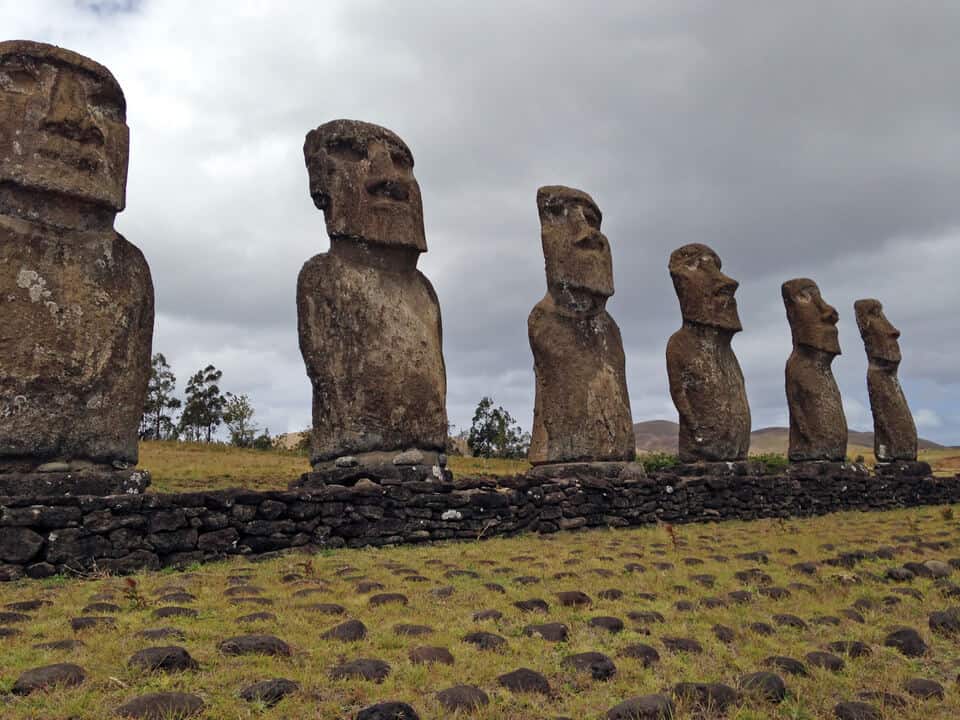
By: Veronika of Travel Geekery
Moai – a word of four letters that the whole world knows. That doesn’t happen with too many South American landmarks!
The Moai statues on Easter Island have earned their fame because of various reasons. They’re unique and cannot be found elsewhere. They exist in large numbers and were created by inhabitants, who didn’t possess any advanced tools. The main mystery lies in how they were transported around the island. And what their actual meaning was.
The large statues were carved out of volcanic rock. Some of them are as tall as 30 feet! They are amazingly heavy too with their weight averaging 14 tons.
The Moai are scattered all over the island. You can find several by the main town Hanga Roa. There are a few famous standing ones on the Anakena Beach, Ahu Akivi, and Ahu Tahai. The best is to rent a car while visiting – that way you can easily see all the Moai, do some hiking and soak in the magic of the island.
The most convenient way to get to Easter Island is to fly from Santiago de Chile. The flight takes about 5 hours and is serviced by planes, which then continue on to Tahiti.
Best Landmarks in Colombia
1. Ciudad Perdida (Lost City)
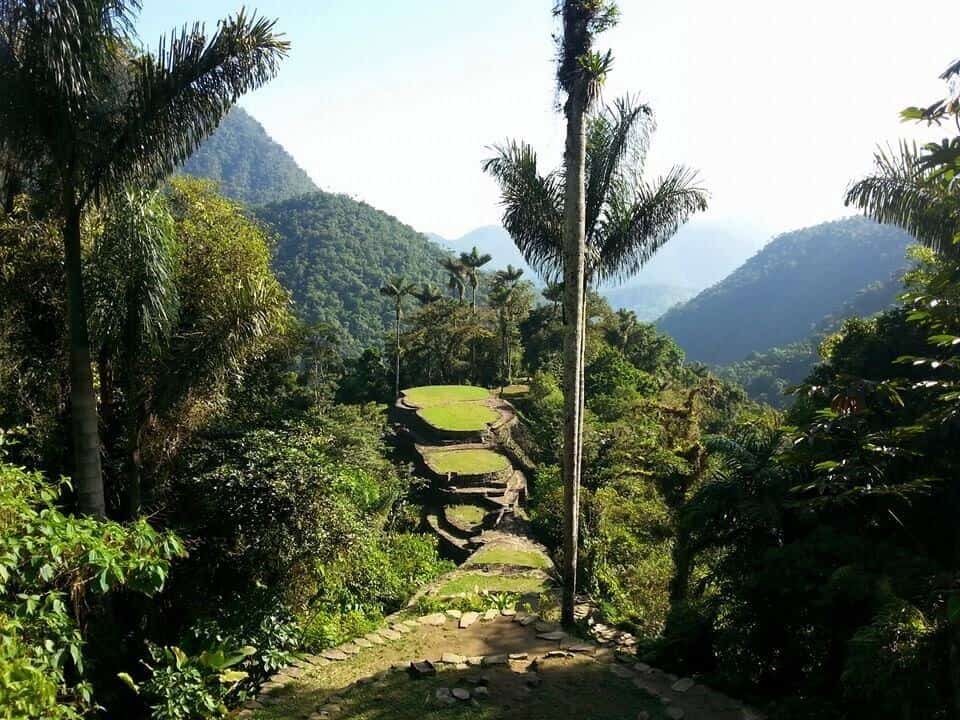
By: Claire of This Travel Lover
La Ciudad Perdida, or Lost City in Spanish, is a special landmark in South America, and one of the must-visit places on any Colombia itinerary.
The Tairona people built the city deep in the Colombian forest around 800 AD but abandoned it during the Spanish conquest.
The city was ‘lost’ to all outsiders for hundreds of years until it was rediscovered by accident in 1972, when some local treasure hunters stumbled across some stone steps leading through the jungle.
The trek to the Lost City takes 4 or 5 days and it is a kind of rite of passage for many backpackers in Colombia. The trek is quite challenging due to the combination of forest humidity, mosquitoes and elevation. Let’s not forget about Colombia’s tropical weather.
It is well worth the effort though.
You must do the trek with a guide, and if you choose a company with indigenous guides descended from the Tairona, they can teach you all about their culture and traditions along the route.
Once you arrive in the Lost City, walk around the terraces, take a dip in the stream and if you’re lucky you may get to meet the local shaman who still resides there.
2. Tayrona National Park
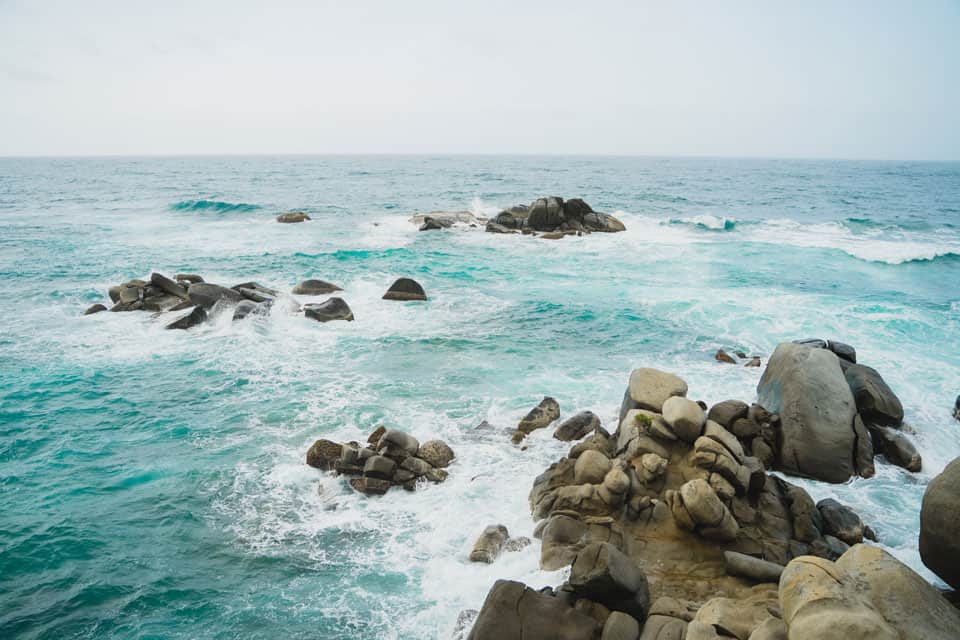
The Tayrona National Park in northern Colombia is a protected area where the lush tropical jungles meet the Caribbean coast. It is an area known for its pristine beaches, many of which offer an extraordinary experience if you decide to camp in Tayrona.
There are many rules when visiting Tayrona National Park, such as no plastic bags (to stop littering inside the park), no music playing (to not disturb the wildlife in the area) and many more. The park is also closed every February so the indigenous tribe that currently inhabit the park can have some peace and quiet.
If you are a seeker of unspoiled nature, then this South American national park is the ideal destination. Make sure you stop by the legendary Cabo San Juan inside the park. It is a place where visitors can sleep in a hammock in a watchtower that juts over the sea.
3. Valle de Cocora (Cocora Valley)
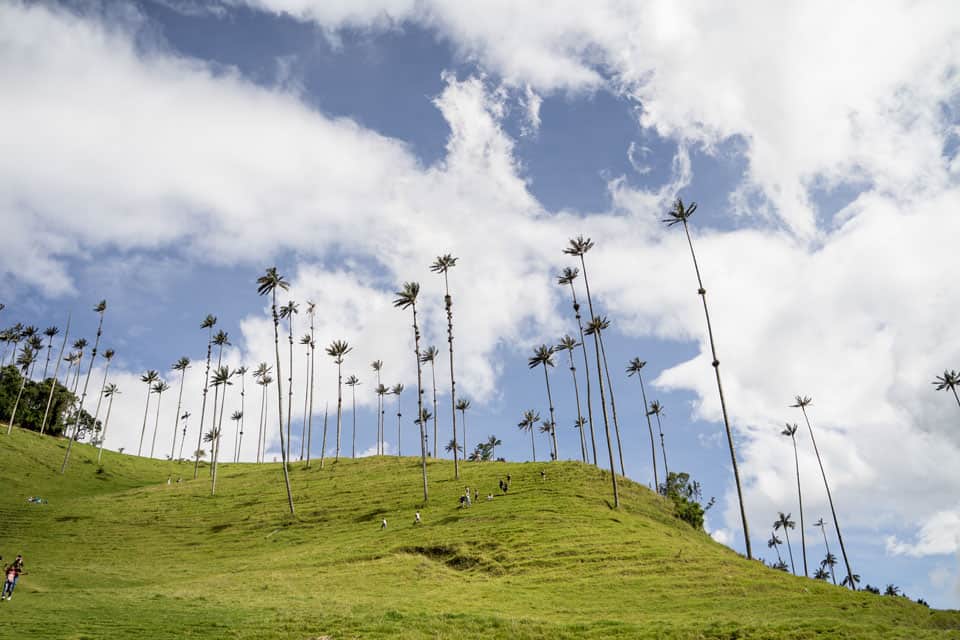
By: Ilona of Top Travel Sights
One of the iconic landmarks in South America that should be on every traveler’s list is the Cocora Valley, or Valle de Cocora in Spanish.
You can find the Cocora valley in the Quindio coffee region in Colombia, and it is home to the highest palm trees in the world. These wax palm trees can grow up to 60 meters tall.
The best way to visit the Cocora Valley is by going on a hike. You have the choice between walking amongst the palm trees on a shorter walk or spending the day hiking a trail that loops through the whole valley.
Besides the wax palm trees, you can also explore lush meadows and trek through the jungle. Make sure to stop by the Casa de las Colibris, where you can enjoy a hot chocolate while watching hummingbirds zipping through the forest.
On rainy days, the path can get muddy, so don’t forget to rent rubber boots at the start of the trail.
To get to the Cocora Valley, you need to take a jeep from the nearby town of Salento. Make sure to arrive early in the morning so you have enough time to hike this Colombia landmark!
4. Comuna 13 in Medellin
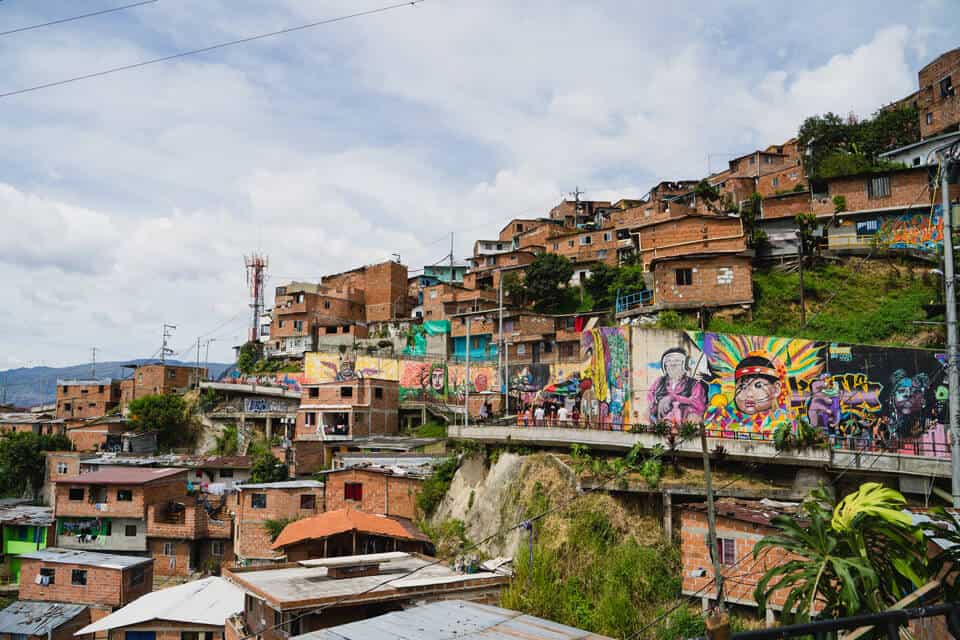
The Comuna 13 is one of the 16 communes in Medellin, Colombia. In the 80s and 90s, Comuna 13 earned its name of being one of the most dangerous neighborhoods in the world. At that time, it was run by drug trafficking gangs, who used the poor locals in the commune to assist them.
Because it was one of the easiest routes to transfer goods (and drugs) off of the city of Medellin, Comuna 13 became a battleground between the drug traffickers and the officials. Many bloodbaths took place in Comuna 13.
Nowadays, the government of Colombia has put an emphasis on developing Comuna 13. To begin, escalators were built in the neighborhood for easier access in and out of it.
Along with many other projects, Comuna 13 became one of the most vibrant communities in Medellin. Instead of channeling their energy into committing crimes and other misdeeds, the residents (especially the youth) focus their energy on creative arts.
Nowadays, the neighborhood is filled with street dancers, colorful murals, and an artistic vibe.
Best Landmarks in Ecuador
1. Ciudad Mitad Del Mundo (City Middle of The World)
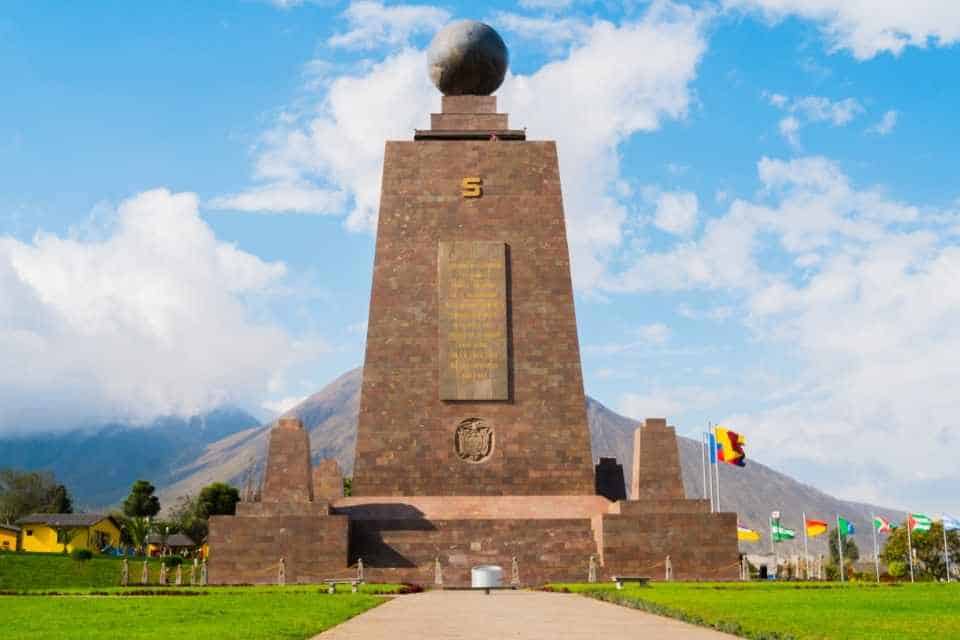
The Ciudad Mitad Del Mundo (or City Middle of The World) is arguably Ecuador’s most famous attraction. As the name suggests, the Ciudad Mitad del Mundo is located in the middle of the world (AKA on the equator), and hence gives Ecuador the name it currently has.
Visiting Mitad del Mundo offers visitors a chance to step in both the Northern Hemisphere and the Southern Hemisphere at the same time. Visitors can also witness firsthand whether toilets flush in opposite directions in different hemispheres or not.
The equator, which is symbolized by a yellow line, runs through Mitad del Mundo. However, many visitors don’t know that the equator is actually a few hundred meters from the yellow line. There was an error when constructing the Mitad del Mundo and due to the lack of modern tools, the equator was a little off. No harm done, right?
Nowadays, a 30-meter-high monument stands proudly on the yellow line. Visitors can enter the monument and learn about the history of Ecuador and a little bit of science involving the equator. At the top of the monument is an observation deck that shouldn’t be missed.
2. Quilotoa Lake
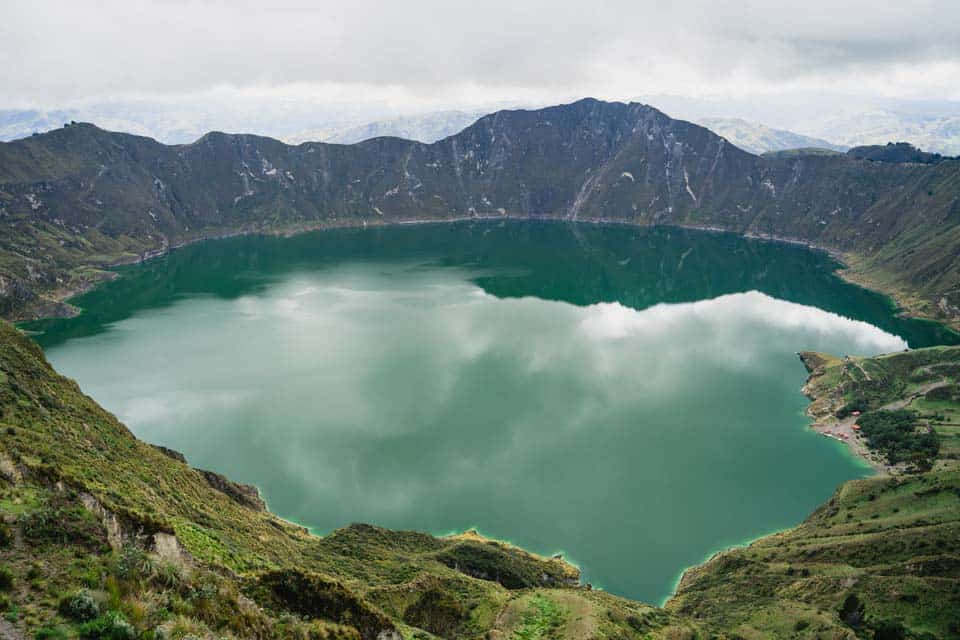
The Quilotoa Lake is a 3-kilometer-wide crater lake that was created in 1280 from a massive volcanic eruption. At the end of the enormous destruction, a gorgeous turquoise lake was formed at the crater.
Nowadays, Quilotoa Lake is one of the most beautiful landmarks in South America. Because of its secluded location and high altitude (approximately 3,800 meters above sea level), reaching Quilotoa Lake is no easy feat.
If you want an easier route, take a car or bus to the town of Quilotoa, which sits adjacent to the perimeter of the crater lake. Avid hikers might want to choose a multi-day self-guided trek through the rugged Andean mountains, where they will arrive at the Quilotoa Lake on the final day.
Swimming in Quilotoa Lake is highly not recommended due to the toxic minerals in the water. Visitors can rent a small boat and paddle out to the middle of the lake. However, just remember that getting to the bottom of the lake from the edge of the crater is a 1-hour hike through steep and tough terrain.
3. Galapagos Islands
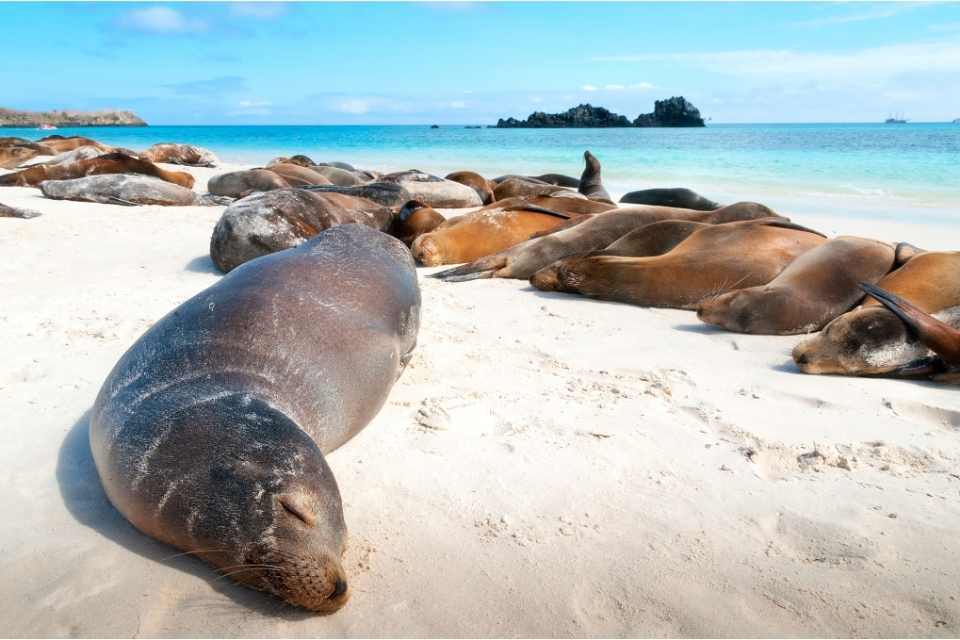
By: Nicole of Go Far Grow Close
The birthplace of Charles Darwin’s theory of evolution, the Galapagos Islands are some of the most unique places in South America. They are located in the Pacific Ocean, approximately 1000 km from the Ecuadorian coast. There are 127 islands – 19 are large and only four are inhabited.
They are found within one of the richest marine ecosystems in the world that has led to the development of unusual plant and animal life. In 1959, the Galapagos Islands were declared a national park and in 1998, the Galapagos Marine Reserve was created, making it one of the largest marine reserves in the world.
The Ecuadorian government strictly limits the number of people who can visit the Galapagos Islands. Most of the islands require a permit to enter, even if it is only for an hour or two. On each island, there are specific trails to follow in order to minimize the impact from visitors.
With the extreme isolation of the islands and the limitations on visitors, most animals are absolutely fearless of humans.
You can easily swim with sea lions, come within inches of marine iguanas (as they quietly walk in and out of the water or the bushes), be within an arm’s length of albatrosses engaging in a mating dance, or walk side by side giant tortoises that can be 70 years old or older.
You can try and book a hotel in one of the four inhabited islands. Then, try and book individual day excursions to uninhabited islands provided there are permits still available for the day. However, it would be far better to save up and book one of the multiday Galapagos cruises.
They have permits for access to the most remote or restricted islands, which usually have the most interesting and rare animals to see. In addition, it is an amazing experience to be on one of the boats surrounded by these beautiful sea and land animals away from civilization.
4. Basilica del Voto Nacional
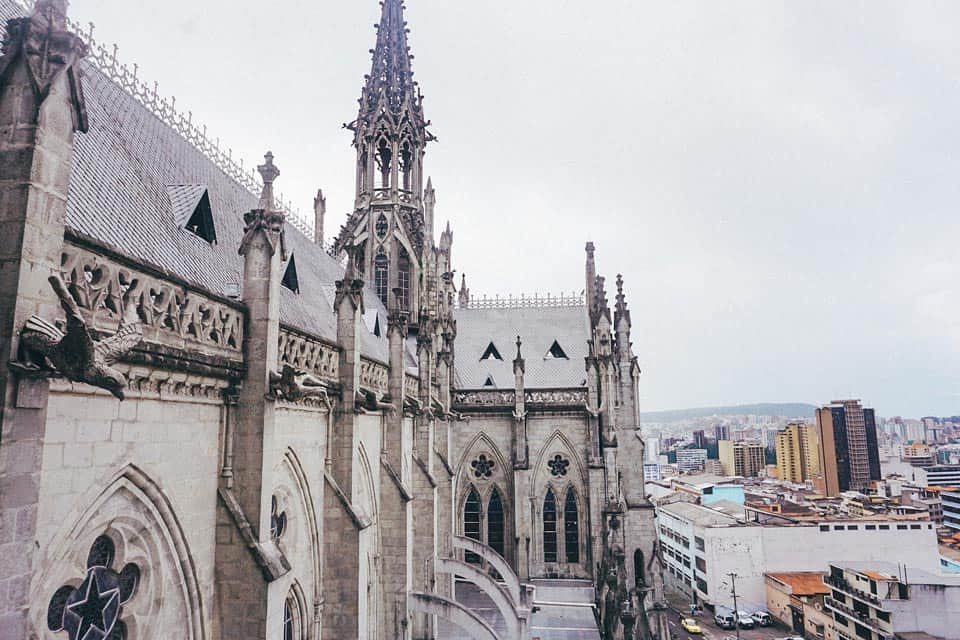
By: Sydney Richardson of A World in Reach
The Basilica del Voto Nacional (or the Basilica of the National Vow) in Quito, Ecuador is an iconic South American landmark that’s famous for its architecture and rich history. The Basilica is located in the heart of the city just steps away from the Historic Center and is one of the top things to do in Quito.
Construction on the Basilica began in 1892, and the Basilica was opened in 1899. To this day, construction on the Basilica has not been completed. Legend has it that if construction on the Basilica is complete, the world will end.
The Basilica del Voto Nacional is famous for its iconic design that includes a neo-Gothic facade, two bell towers, and an impressive dome. When visiting the Basilica, you can explore the famous church, admiring its architecture and intricate stained glass windows. Admission to enter and explore the cathedral is just $2 (at the time of writing).
A highlight for most visitors is climbing up the towers to the top of the Basilica. For just $2 more (at the time of writing), you can ascend the towers and be rewarded with panoramic views of the city. The climb up involves climbing up steep steps and ladders, so it’s only for the brave!
Best Landmarks in Paraguay
1. Itaipu Dam
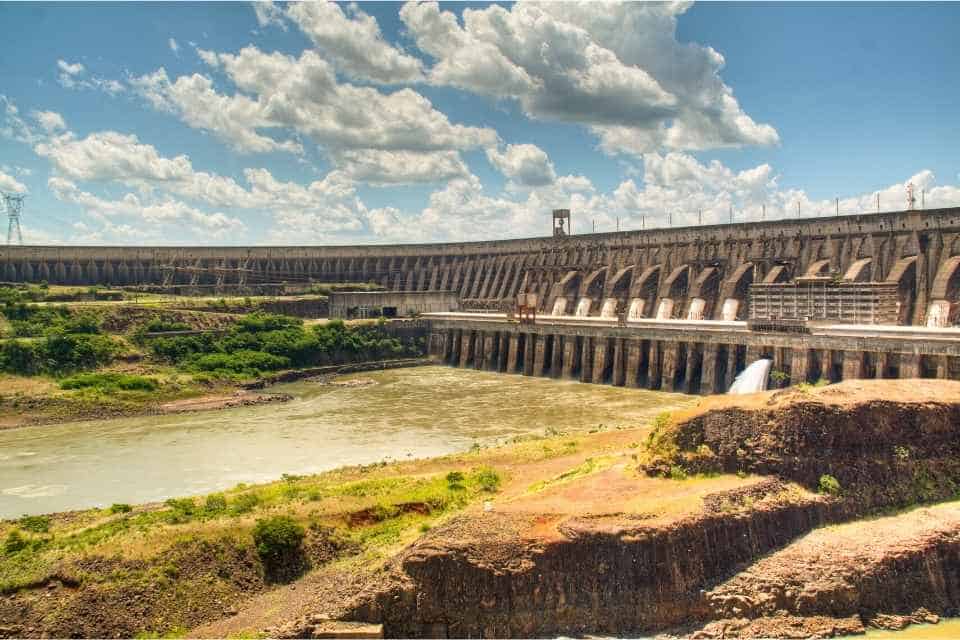
By: Christine of Romantic Places Insider
The Itaipu Dam is a massive hydroelectric dam and the world’s largest generator of renewable energy located on the Paraná River, between the borders of Brazil and Paraguay. It is one of the world’s largest dams, providing 80 percent of the electricity required by Paraguay and 20 percent of the electricity required by Brazil every day.
It is one of the most spectacular man-made landmarks in South America.
The Itaipu Dam complex may be visited from both Paraguay and Brazil. Most visitors opt for the “panoramic” tour which includes a short film on the dam and a guided sightseeing bus that takes visitors around the dam. There is also a technical tour that takes guests inside the control center, which must be booked ahead of time.
During the tour, the bus stops at the main observatory for a scenic view of the floodgates, the main dam, and the Parana river in the distance. From here, visitors can admire one of the finest achievements of modern engineering, now one of Foz do Iguaçu’s primary attractions.
Apart from the views, Itaipu Dam is noted for its evening light shows. Visitors to the dam, particularly those on the Paraguay side, should stop by the Museum of the Guarani Land to see unique displays of indigenous culture.
The Tat Yup Sanctuary, located just north, is a beautiful nature reserve that’s also worth visiting.
Best Landmarks in Peru
1. Machu Picchu

Machu Picchu, one of the most visited Seven Wonders of the World and a UNESCO World Heritage Site, is undoubtedly the most famous icon in Peru and one of the most famous landmarks in South America. Built by the Inca Empire, it is believed that Machu Picchu was abandoned when the residents went off to help with the war against the Spanish invasion.
Perched on a hill, Machu Picchu was secluded and the Spanish never discovered it. It wasn’t until 1911 that American archeologist Hiram Bingham “found” it. Because it was never looted or destroyed by the Spanish, Machu Picchu is in perfect shape (minus the slight weathering from natural elements).
When you visit Machu Picchu today, you see an undisturbed piece of history of the almighty Inca Empire. Make sure you include it on your Peru itinerary!
2. Nazca Lines
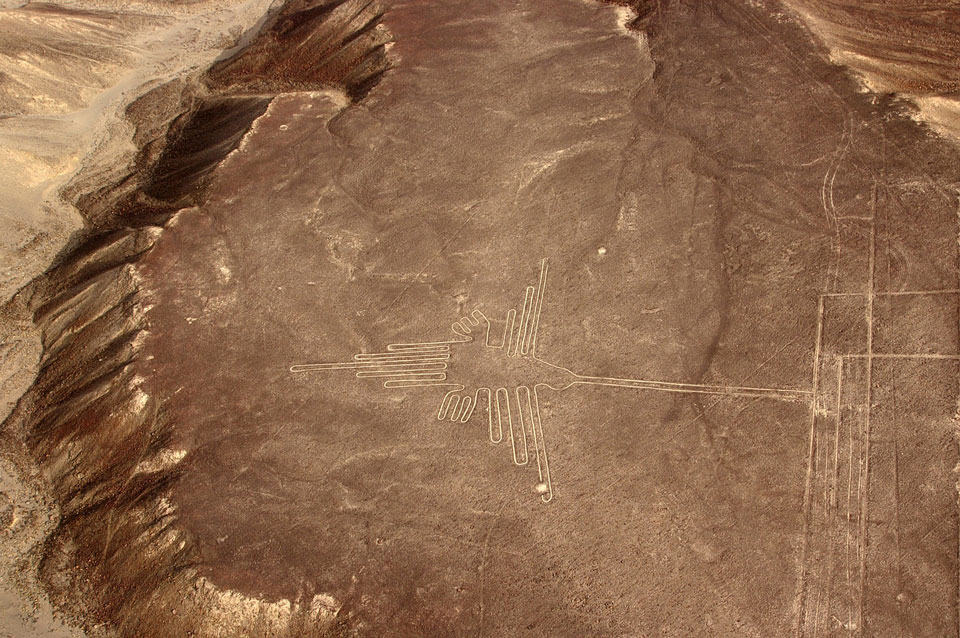
By: Sharon from Baby Journey
The Nazca Lines are one of the most iconic landmarks in South America as well as the most mysterious. Located in the deserts of Peru, about 200 miles southeast of Lima, the lines themselves are strange incisions and depressions in the desert which were made by removing rocks that left different colored dirt exposed.
The lines are estimated to have been created between 500BC and 500CE and there are hundreds of them including 300 geometric figures and 70 plant and animal designs. They were largely forgotten until people started flying over Peru and they were spotted by pilots.
From the ground, the lines aren’t really noticeable and there is no way to see the patterns so you need to take a flight or climb up a viewing platform.
Scenic flights depart regularly and this is the best way to see a range of the lines and shapes which cover a huge area of the desert. The flights start at 30 minutes long and around US$80. You’ll only see a subset of the lines on your flight so if you have a particular shape you want to see, make sure you mention this when booking to get the appropriate flights.
It’s also possible to see them without a flight, although you won’t see as much. The Nazca Lines Observation Tower on the road into Nazca from the coast is the perfect starting point.
This platform is 42 feet tall with stairs and is a quick, easy and cheap way to see the lines that form a Tree, Hand and Lizard.
If you are looking for things to do in Ica, a nearby city, don’t hesitate to include the Nazca Lines!
3. Colca Canyon
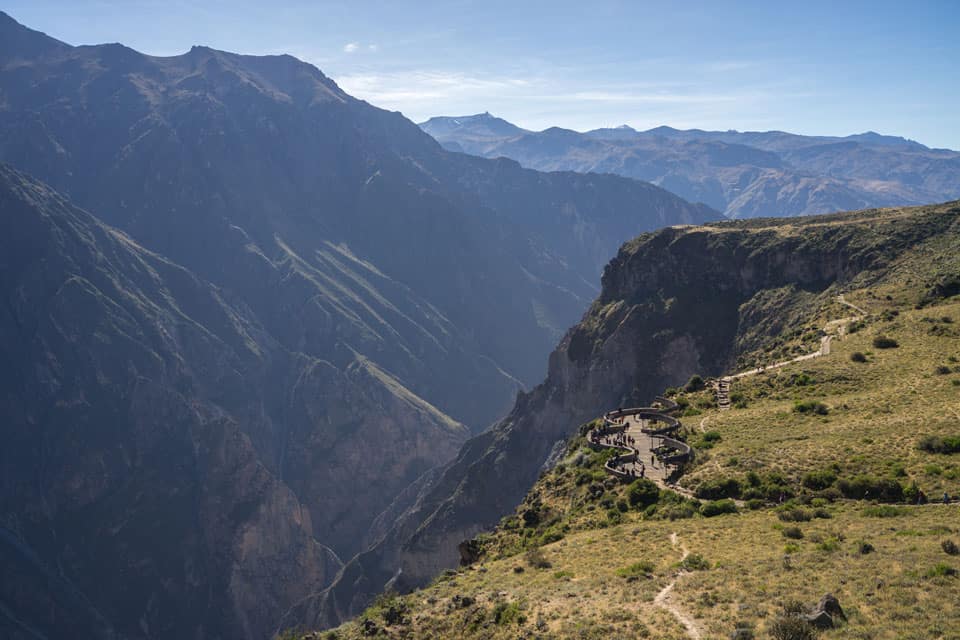
By: Linn Haglund of Brainy Backpackers
In Peru, you’ll find one of the most astounding landmarks in South America, Colca Canyon, the second deepest canyon in the world.
The dramatic geological feature goes 3270 meters deep and is dominated by lush valleys covered with fruit trees. Local farmers working in this area still follow the traditions of the Inkas.
Floating above Colca Canyon, you can admire one of the largest species of birds, the majestic Condor. With a wingspan of around 3 meters, it’s a unique experience to see them in real life. The condor represents the heavens, one of the three stages of Inca life.
You can book guided tours to see Colca Canyon and the condors in Arequipa or if you want to get up close with this natural wonder, a two-day Colca Canyon trek is your best best.
The hike includes a night at an oasis at the bottom of the canyon and the ascent up to the top again will start long before sunrise. Even though it is one of the harder hikes in Peru, it is absolutely worth it.
4. Las Salinera de Maras
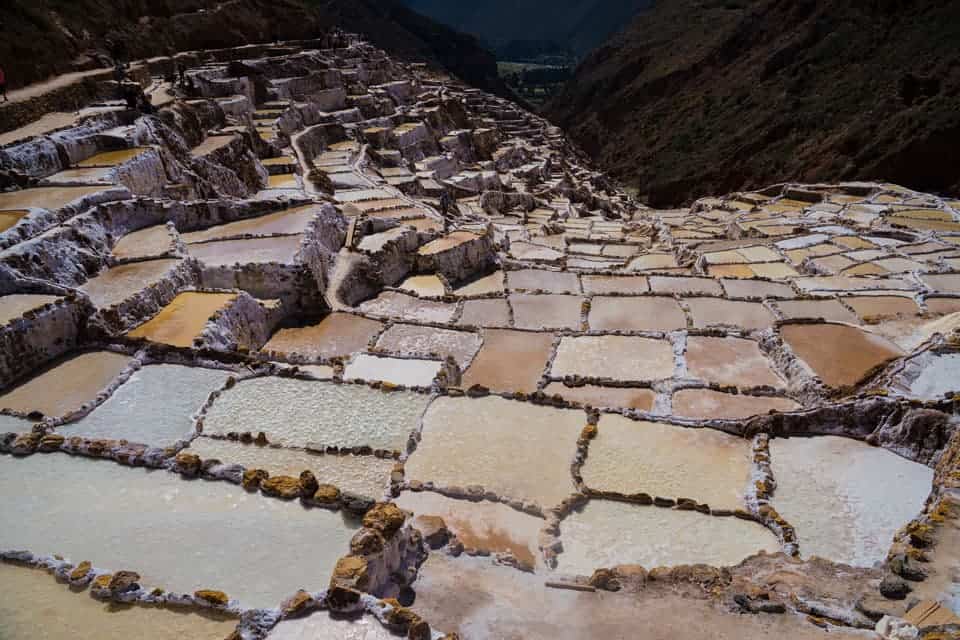
By: Michelle of Moyer Memoirs
Las Salineras de Maras are natural salt mines in the Sacred Valley of the Incas in Peru. They are located in Maras which is 40 km north and an hour’s drive from Cusco.
They were formed millions of years ago and harvested before the time of the Incas. It is amazing that even today, the local families still mine the salt from this area.
There are several thousand individual mines that are each owned by a local family and viewing them all is a spectacular sight.
The entrance fee for this popular site is 10 soles (about $3 USD at the time of writing) and they only accept cash. The observation platform is at the entrance high above the mines and offers a great view of the entire region as well as the opportunity to watch any families going through the salt harvest process.
The Maras Salt Mine is one of the few places on Earth that produces pink salt, and visitors can have a chance to purchase some in one of the several small market stalls near the entrance of the mines.
If you are visiting with a guided tour (which you should), it will include a visit to the Moray archaeological site, one of the “science labs” of the Inca empire.
Best Landmarks in Venezuela
1. Angel Falls
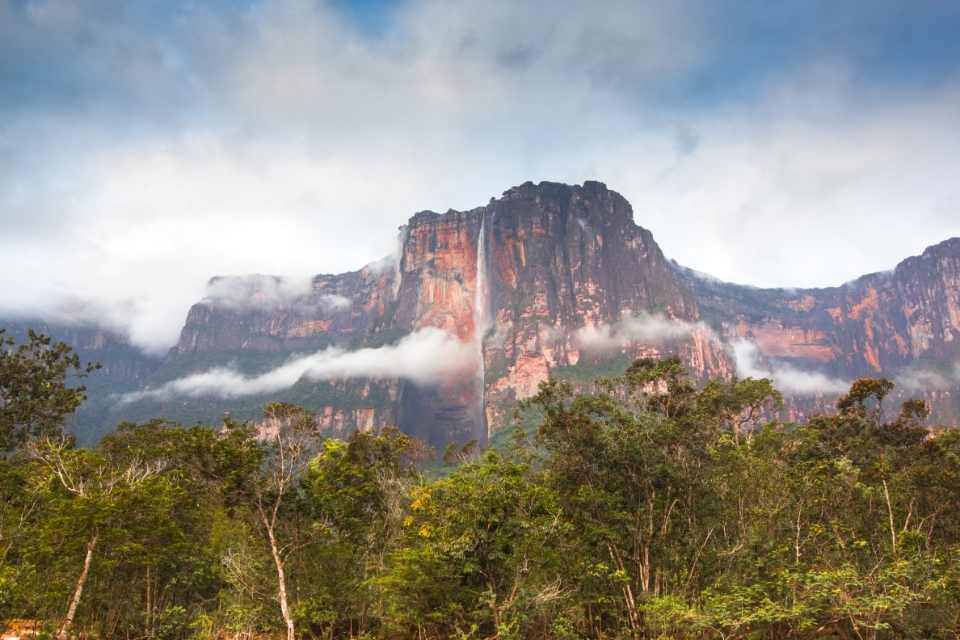
No list of the best South America landmarks would be complete without including Angel Falls in Venezuela, the world’s tallest uninterrupted waterfall. The waterfall has a total height of 979 meters with a plunge of 807 meters.
Located in the Canaima National Park, the water tumbles over the mountain Auyán-tepu into the Devil’s Canyon, 979 meters below. Seeing this natural wonder with your own eyes is truly a once-in-a-lifetime experience, but it is no easy feat as the country of Venezuela is under turmoil (at the time of writing)
Besides, Angel Falls is located in the wild and untamed forests of Venezuela. There are no roads that go into the park, so your only option is by air. Once you are there, you will still need a professional guide to help you navigate.
Most Iconic South America Landmarks Map
Above is our map of all the South American landmarks we have talked about. As you can see, almost every country in South America has an iconic landmark worth seeing. Using this map, hopefully you can create an epic South America itinerary where you can see as many of its wonderful landmarks as possible!
South America Landmarks FAQs
What Are The Two Major Landmarks In South America?
What Is South America Most Famous For?
Like this post? Don’t forget to share it on Pinterest!
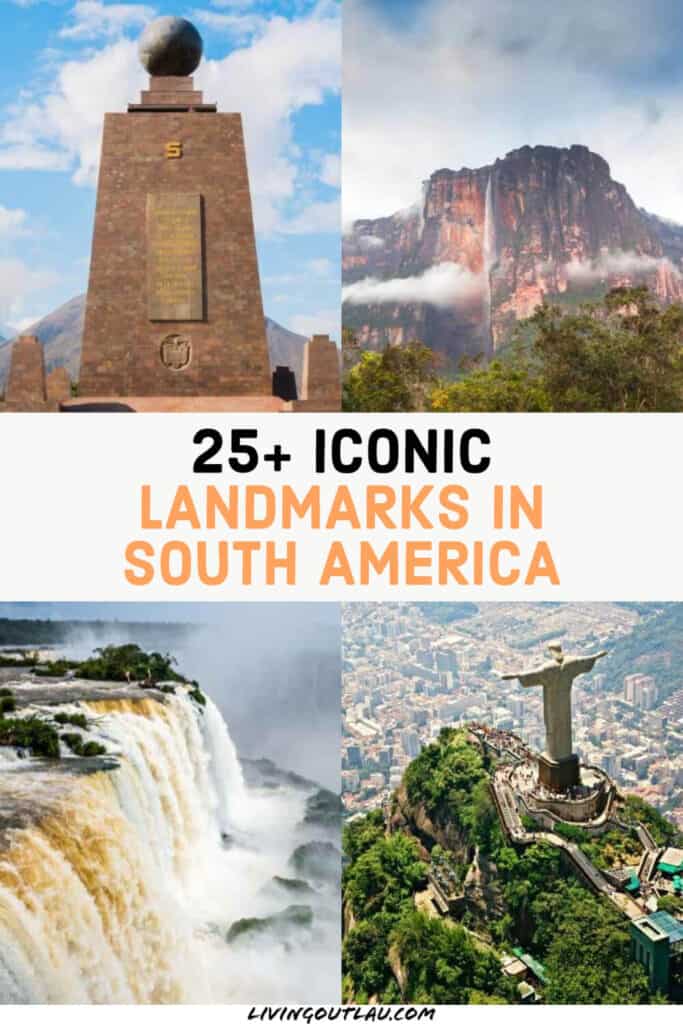
This concludes our post on the 25+ most famous landmarks in South America. Hopefully, you have a landmark that sparked your interest in South America!
Any questions? Leave them in the comments!
Disclaimer: Some of the links above are affiliate links. That means if you book or make a purchase through the links, we will earn a small commission at no extra cost to you! The money will help run this site! Thank you!
